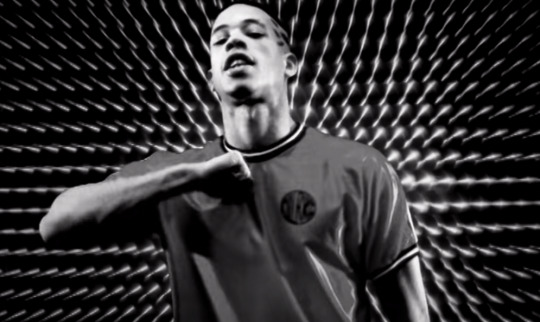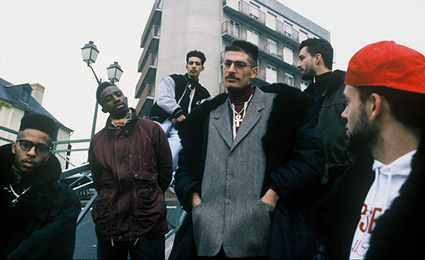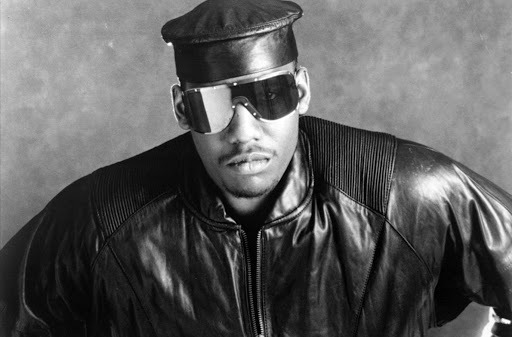rap music has invaded our screens from the US to France. let's have a look...
Don't wanna be here? Send us removal request.
Text
The first French series on rap, "Validé" by Franck Gastambide (2020)

Millions of fans have dreamed of it, Franck Gastambide has done it: "Validé", the first French series on rap. The lease? A drama of 10 episodes of 30 minutes on the backstage of the most listened to music in France. We follow the journey of Clément, aka Apash, a small neighborhood dealer who becomes the rising star of French rap. A destiny punctuated by obstacles, low blows and media operations.
French rap, a family turned in on itself, needed to look at itself through a fiction at a millimeter of reality. In other words: there was a need to dismantle the door of taboos and great fables that undermine it. Interviews turn from time to time to the basket of banalities and concreted storytelling. Artists swear that the meters do not panic them, that the look of the others does not reach them, that the competition exists only half because, in the bottom, there is place for everyone. That their neighborhood is behind them because they are their pride. The rapper who aims for fame without the manner is more mathematician than poet. Streaming, views, checks, web tricks to inflate his success: if we took away his numbers, right now, he would be convulsing like a junkie. Around the rivalry of two rappers, Franck Gastambide's fiction plays with the clichés of an environment that verbal exaggerations and advantageous postures do not scare. The flamboyance, the weight of the neighborhood, the clashes of ego, everything is there.
Far from the aesthetics of the suburbs and the denunciation of its conditions as "La Haine" or "Ma 6-T va crack-er", "Validé" is the bling-bling side of rap, clichés to rain. It is nonetheless an engaging series, with a touch of humor and a 100% rap soundtrack.
0 notes
Text
"Ma 6-T va crack-er" by Jean-François Richet, 1997

"Ma 6-T va crack-er" is set in the daily life of the underprivileged suburbs. We follow the daily life of several characters, most of whom are inhabitants of these cities, playing their own roles. None of them has a future, they are locked in a permanent present. They become outcasts who have no control over their destiny. They are victims of society, unemployed, forgotten, who can't get out of it, have no goals to reach or landmarks. They are rejected by society and reject it in turn. Their life becomes misery and delinquency a way to survive. Every day, they are subjected to constant repression, which gives them a spirit of rage and perpetual violence. This leads to a refusal of any authority, parental, school or police. The film is not only a report on the failure of life in these suburbs. It proposes solutions to change their conditions of existence: to mobilize collectively, to join the workers to go on strike, in order to put pressure on and affect the economic interests of the leaders. The film ends with a riot scene unmatched in fictional cinema. The sequence lasts twenty minutes. By this ample duration it is incredible and intense.
The film was shot in 35 mm and has a certain grain, which contributes to the documentary aspect of the film. It alternates still shots and short shots, unlike La Haine, which lines up very "polished" sequence shots. The camera has an amateurish feel (shaking), due in part to the fact that the shots were shot by two cameras. The cameramen therefore move to avoid entering the field of the other. This live aspect is reinforced by the amateurism of the actors. We have the impression of a real immersion in a suburb.
On the other hand, the music, the rap, has a dominating role. It totally gives rhythm to the film. The rap uses a musical background, the beat, which always returns in loop. This music illustrates very well the youth which turns in circle in the cities. Richet even included a rap video in parallel to the riot scene. The film gave birth to a cult rap album.
Here the music is not just "inspired by". The brothers Mike and Fabien Kourtzer, who form the duo White & Spirit, are not only in charge of the instrus of each MC (except the track of Assassin, conceived in an external way) but well and truly of the whole musical dressing of the film. That is to say, there are practically all samples or at least variations of rap classics within the film itself in different scenes. Looking closer at the album, it's easy to see why it's now considered a classic. Between the 5 star cast that includes Assassin, Stomy, IAM, Passi, The X-Men, and even the American KRS One, not to mention of course 2 Bal 2 Neg and Mystik, it's easy to see why it's left a mark. Even at the time, the album went gold quite quickly, and we're talking about the gold record of the 90s: 100,000 copies sold in physical form.
0 notes
Text
"La Haine" by Mathieu Kassovitz, 1995

A normal low-income housing project, with no specific problems, wakes up one morning under siege. The youths of the Muguets neighborhood have spent the night waging war on the police. The reason? Abdel Ichah, 16 years old, is between life and death, wounded by a police inspector during an interrogation... One more blunder for one more riot.
The idea for the film was born by Kassovitz the day after the Makomé M'Bowolé case. Named after the young man who was shot in the head at point-blank range by a police inspector who wanted to intimidate him while he was in custody in a police station in the 18th arrondissement of Paris.
A quarter of a century after its release, "La Haine" is an almost sociological testimony of life in the suburbs. If they have changed, the question of religion, omnipresent today, is for example totally absent from the film, what Kassovitz describes seems unfortunately always current: violence, drugs, insalubrity, promiscuity ... But also good humor, brotherhood and creativity.
The choice of black and white gives a very urban, graphic character, allowing to distinguish itself from the French realistic film. The suburbs are fantasized by the aesthetics and the staging with many sequence shots. Kassovitz feeds his film with what was his main influence for his political commitment: hip-hop. We can thus see DJ Cut Killer mixing "Nique la Police" by NTM and "Je ne regrette rien" by Édith Piaf, but also young breakdancers. The soundtrack of the film is also signed Ministère A.M.E.R. and its famous song "Sacrifice de poulets". The French director deals with the suburbs on a background of rap music, the appropriate medium. This use of rap music gave birth to a mythical scene in the film, that of DJ Cut Killer, setting up his set on the window sill at the top of a low-income housing project so that the whole city could enjoy it.
"It's the story of a society that falls and as it falls, repeats itself over and over again to reassure itself: "so far so good, so far so good, so far so good". The important thing is not the fall, it's the landing. "
0 notes
Text
The music video

The music video emerged in the 1970s in the United States, thanks in particular to the very famous rock group, Queen, and their video for the song "Bohemian Rhapsody". The music video is now widely popular, and what interests me is the aesthetic and political composition of the images, illustrating and deepening the words of French rappers. Through music videos, rappers are invited on our screens.
The group Suprême NTM is one of the first rap groups to be known and to be mediatized. It is with this song, "Le monde de demain" that the group gains notoriety in 1991. It is the first clip of French rap, with black and white aesthetics, directed by the photographer Stéphane Sednaoui and where the clothes are signed Jean-Paul Gaultier. The duo expresses the socio-political problems that persist in the suburbs. It is a part of the ignored and angry youth that will expose itself to the camera, with Joey Starr and Kool Shen in the foreground. In this way, they position themselves as loudspeakers of the youth of the suburbs as Kool Shen says in his verse quoted on the previous page.
The clip shows the different faces of the suburbs, all ethnicities and religions, united in the face of the government's inertia. The piece reports the malaise of the young people of suburbs, the will of a change, a call for help. The clip will serve to illustrate these remarks by showing faces, putting us in front of a reality. The use of black and white can appear as the mixture of ethnicities, black or white there is no difference in this layer of the multiracial society. We also find at one point, a child's face, symbol of purity and innocence, condemned to live in violence, unemployment and stigmatization if nothing changes.
0 notes
Text
Rap and Ghetto

The suburbs, the cradle of French rap music, were hit by urban riots in the 1980s. Indeed, rap music is built in a violent environment, reporting the social malaise of the inhabitants of the big complexes, stigmatized and precarious. The suburbs, as well as rap, attracted media interest from 1990 onwards and became inseparable.
Rap offered a means of expression to a marginalized community. To make conscious rap is to speak out politically, to challenge and to engage. Associated with the social and political context, conscious rap stands out in the 1990s with the first hit by Suprême NTM.
This youth from the suburbs denounces the difficult and discriminatory life in the suburbs, as well as the racial stigmatization of which they consider themselves victims in their daily lives through a culture and an art that they have appropriated. These texts express the revolt of a popular community that feels excluded from the economic and social life accessible to all citizens.
If rap has a violent image, it is nevertheless a real artistic practice that has imposed itself in our playlists as well as on our screens.
0 notes
Text
When rap arrived in France

"People thought it would last two months, two years, that hip-hop was a passing fad, it's been 35 years and we are still here. "This sentence was uttered by Kool Shen, member of the famous group Suprême NTM during their final concert at the AccorHotels Arena in Bercy on November 23, 2019.
A few years earlier, Laurent Bouneau, Skyrock's general manager of programs, wrote in his book, "We thought this movement was a US fad that wouldn't catch on here. "More than thirty years have passed since the first stammerings of rap, a musical genre characterized by its very rhythmic and rhyming diction, on the French territory. And while no one would have bet on the rise of this movement, France has become the second most rap-producing country, just behind the United States. Rap is more prolific than ever, its industry is doing very well and dominates music consumption in France.
French rap had its golden age in the 1990s. During this decade, rap was the talk of the town and albums claiming to be rap were released. 1990, it is the decade where the rap comes to maturity. Rap offered a means of expression to a marginalized community. To make conscious rap is to speak out politically, protest and commit. Associated with the social and political context, conscious rap stands out in the 1990s with the first hit of Suprême NTM.
0 notes
Text
New Jack Cinema

“Menace II Society” by Allen & Albert Hughes (1993)
Like all genre films, hood movies respond to a thematic and aesthetic code. Indeed, these films deal with life in the ghettos, especially inhabited by a majority of African-Americans. Mixing violence, weapons, gangs and especially drugs on a background of rap music. The characters live in misery, the black American journalist Barry Michael Cooper explains: "the culture of the streets present in the new jacking is translated by the increased desire that most of the young people of the big cities show to have cars, clothes and jewels out of price, made accessible by the only means of the drug trafficking". These films are therefore synonymous with gang warfare, drug trafficking and shootings: their way of surviving in the ghetto from which they hope to escape one day, they give an account, in the most authentic way possible, of the misery and social conditions of black Americans in the United States: a society of those left behind, victims of discrimination.
To illustrate this, we can take the example of the film "Menace II society" by Allen and Albert Hughes. Indeed, we discover the aspects of the life of the black minorities of Los Angeles: drug trafficking, evenings wandering in the streets, urban violence and raw language. In addition, the film opens with footage of the 1965 Watts riots and police violence in Los Angeles, and the film takes place a year after the 1992 Los Angeles riots.
Furthermore, these films have a singular urban aesthetic, the basis of which is characterized by the music, that vindictive rap: heir to decades of oppression and suffering.
1 note
·
View note
Text
The Legacy of Blaxploitation - “Wild Style” by Charlie Ahearn (1983)

The emergence of films dealing with hip-hop culture is due to the legacy of Blaxploitation in the 1970s, an American cultural and social trend that revalued the image of African-Americans. Indeed, Blaxploitation gave them a prominent place, they were the kings of the screen. The aim of the films was also to have an excellent musical score by taking advantage of the talent of black musicians of the time. Hip-hop films from the 1980s onwards were part of this continuity. In the 1980s, hip-hop became a fashion phenomenon and there was a desire to bring the codes of the movement to light.
If the films are rather recreational, they offer an immersion in the hip-hop culture in all its forms: music, clothes, break-dance, graffiti and also the way of speaking.
"Wild Style" directed by Charlie Ahearn in 1983 is considered the first hip-hop film: we are immersed in the Bronx, where despite the crumbling buildings and the insecurity that reigns, the joy of living is very present. Later, the films "Beat Street" by Stan Lathan (1984) and "Kush Groove" by Michael Schultz (1985) were released, giving birth to a genre in its own right, the hood movie.
2 notes
·
View notes
Text
Introduction

Afrika Bambaataa, 80′s
"Rap, smurf, break, tags, graffiti, Zulu Nation... These words, a little strange for those who are not free, represent the visible part of a movement that is developing. A true culture, hip-hop has a language, a state of mind, signs of recognition, a memory, a prospective, the feeling of a claimed or attributed belonging. "
At a time when the hip-hop movement has largely established itself as a culture in its own right, well beyond a simple trend, rap is establishing itself as the dominant musical genre in the international musical landscape.
Hip-hop culture is rooted in a population on the bangs of American society, an underprivileged African-American population prey to the abandonment of their neighborhood. A so-called "street culture" that has developed its own system of norms, values, and language thanks to several artists who have become mythical in hip-hop culture.
American cinema has had a romance with Hip Hop culture since the 1980s. The emergence of Hip Hop in the film world gave African Americans a front row seat in the cinema, and provided a glimpse of life in the ghettos. These films gave birth to a specific genre called hood movies. Hip-hop music, rap, is obviously omnipresent, but other hip-hop disciplines such as dance and graffiti are also featured. More than just films about rap, hood movies deal with deeper subjects, such as the difficult life in the American ghettos, misery, drugs, violence and especially racism, which is ubiquitous in these films.
Here is the subject of this page, the link between rap and the arrival of hip-hop culture in the world of cinema and audiovisuals, both in the United States and in France.
2 notes
·
View notes